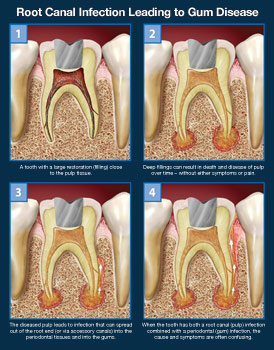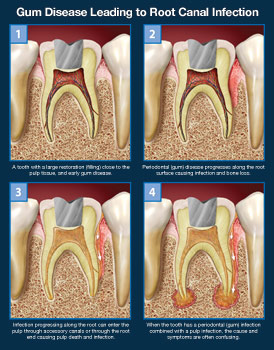Confusing Tooth Pain
Combined Root Canal And Gum Problems
Dear Doctor,
I had a bad toothache and couldn't tell whether the pain was actually coming from my tooth or maybe my gum. Seems like it took my dentist a while to figure it out, too. Can you tell me why this was so complicated?

Dear Alicia,
There is good reason why it is occasionally difficult to pinpoint the origin of tooth pain, which can result from an infection of the tooth itself, or of the gum, or even spread from one to the other. Nevertheless, it's always important to sort out what's going on so that the right treatment can be selected and the tooth saved.
First Comes The Chicken, Then The Egg
When a tooth becomes decayed, bacteria can infect the dental pulp, the sensitive living tissue in the root canal, which is housed deep inside the tooth. This is known as an endodontic (“endo” – inside; “dont” – tooth) problem. Pain symptoms can vary, being sharp or dull, constant or intermittent, localized or spread out. The pain can also be triggered by a stimulus — temperature or pressure. While there are certainly nerve fibers that convey pain, there are no nerves that signal, “it's this tooth right here.” Instead, pain may be felt as if it were coming from a group of teeth, or can even feel like it's coming from your sinus in the case of an upper back tooth.
In fact, after acute pain passes and the diseased pulpal tissue dies, the pain may fade, become chronic or even go away, but the problem won't. It may spread to the periodontal ligament (“peri” – around; “dont” – tooth), the living tissues that encase the tooth, attaching it to the bone and the surrounding gum tissues. Occasionally, infection of endodontic (root canal) origin can spread out from the end of the root where it exits the tooth all the way up the periodontal ligament, and cause a gum problem. This may be revealed as an asymptomatic periodontal pocket — a detachment of the gum tissues that your dentist can trace back to the point of origin in the root canal — or a painful gum abscess. If you have an abscess, you'll most likely know which tooth it is, because the periodontal membrane has a rich supply of nerve fibers to relay the pain, letting you know exactly which tooth it is. This situation is known as a primary endodontic-secondary periodontal problem, meaning the infection started in the tooth and then spread to the gums.
 |
| Click to enlarge |
 |
| Click to enlarge |
Or Is It The Egg And Then The Chicken?
Let's back up now and look at the reverse: dental pain that originates from the periodontal (gum) tissues. Common periodontal disease caused by a build-up of bacterial biofilm (plaque) along the gum line can lead to inflammation and infection of the gums. This results in detachment of the gum tissues along the tooth surface, also known as periodontal pocket formation. In advanced cases, the infection can travel to the end of a tooth and into the tissues of the dental pulp — a so-called primary periodontal-secondary endodontic problem. You may feel this as both periodontal (gum) and endodontic (root canal) pain.
It gets even more complicated when you consider that some teeth have lateral canals — root canals that branch off from the main canal (like the root system of a plant) and exit the tooth not at the end of the root, but somewhere along its side or in an area where teeth with more than one root join each other.
Fractured teeth may also cause both endodontic (root canal) and periodontal (gum) pain, depending upon which structures the fracture involves.
A Good Time To Call A Specialist
I hope you can begin to see why it can be difficult to determine the cause of dental pain when its origins are complicated. It may be necessary for a general dentist to refer cases like this to an endodontist (root canal specialist), or a periodontist (a specialist in diseases and disorders of the supporting structures of the teeth) — or both, to figure out what's going on. It can take some fairly sophisticated know-how and experience to determine the root cause of the problem (no pun intended). The specialist will take a detailed history of the pain symptoms, test the responsiveness of the tooth to temperature and pressure, and evaluate radiographs (x-ray pictures) in order to help make a diagnosis.
The fact is that once dental disease becomes a combined periodontal-endodontic problem, the long-term outlook (prognosis) for the tooth is compromised. And it's here that the determination of which came first, the chicken or the egg, is important:
- In the case of a primary endodontic-secondary periodontal problem, the long-term outlook for the tooth is reasonably good if the tooth involved receives root canal treatment. Any bone loss will usually heal, unless periodontal infection is longstanding.
- Conversely, in the case of a primary periodontal-secondary endodontic problem, there is usually so much bone loss from the gum disease that the long-term outlook for the tooth is extremely poor, if not hopeless.
We hope this gives you an idea of why some toothaches aren't as simple to figure out and treat successfully as we'd all like them to be.


